
Wood floors are more than just a design element in your home—they’re an investment. Over time, however, even the most durable hardwood floors can show signs of wear, from scratches to fading. Refinishing is key to maintaining not only the beauty of your floors but also their longevity and structural integrity. This is especially true when you own premium hardwood floors crafted by Amish artisans, who use time-honored techniques to create timeless pieces. These handcrafted floors deserve special care, and refinishing is an essential part of their upkeep to preserve their quality for generations.
Key Takeaways
- Amish wood floors are crafted from premium hardwood, requiring special care during refinishing.
- Refinishing rejuvenates the surface and protects the integrity of both Amish and standard hardwood floors.
- The right finish can enhance the beauty and longevity of your floors.
This guide walks you through everything you need to know about refinishing your wood floors—from understanding the process to gathering the necessary tools.
Amish Wood vs. Standard Hardwood: What Makes a Difference in Refinishing?
Amish wood floors are different from regular hardwood. When you step on floors made by Amish craftsmen, you’ll know right away. The dense hardwood, chosen grain patterns, and meticulous workmanship make these floors a long-term investment. But when it’s time to refinish, they need to be treated differently than mass-produced hardwood.
Amish hardwood is often denser, meaning it wears better and can go longer between refinishing. Whether it’s the smooth, rich tones of cherry or the rustic character of oak, the grain patterns are unique and hand picked, each floor has its own personality. Unlike regular hardwood, which is more uniform, Amish floors have natural variations that are charming. When refinishing, preserving those patterns is key.
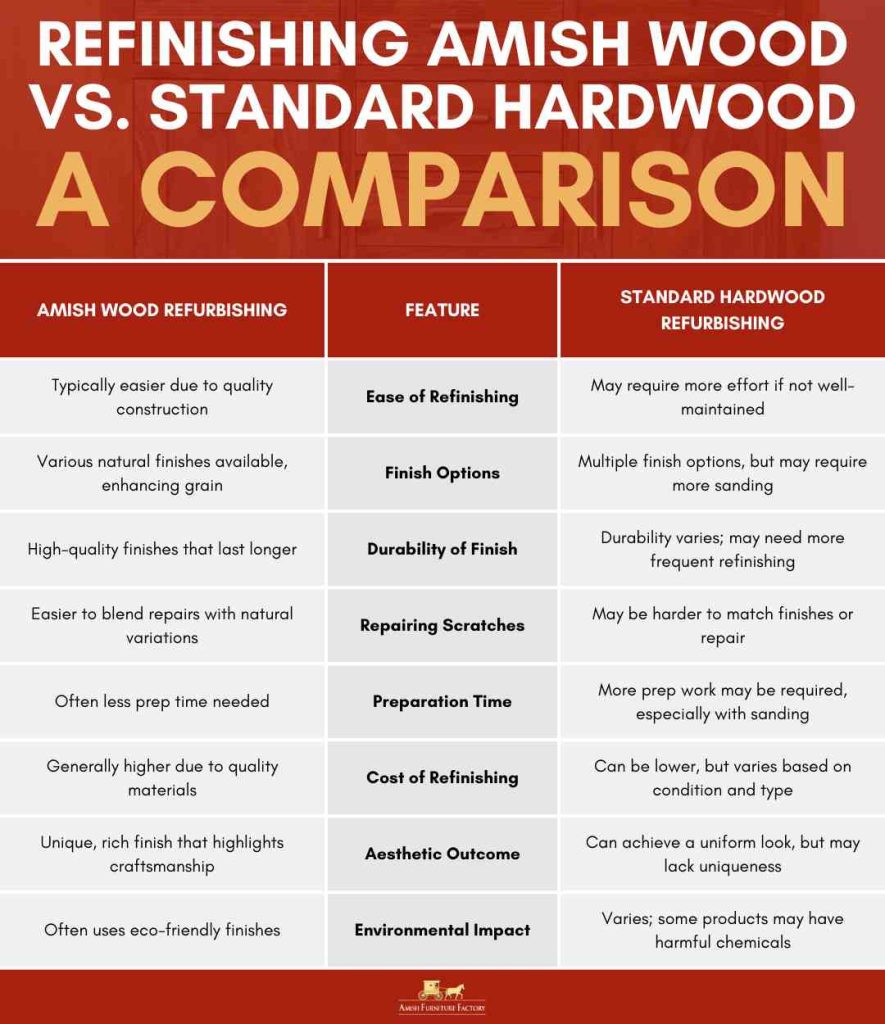
Understanding When and Why to Refinish
Refinishing Amish wood floors is essential for preserving their unique craftsmanship, protecting the wood, enhancing natural beauty, and extending longevity. Handcrafted with meticulous attention to detail, these floors feature intricate grain patterns that stand out from standard hardwood. Regular refinishing not only restores the surface but also protects this artistry by reinforcing the finishes that penetrate deeply into the wood, safeguarding against scratches and moisture damage. Additionally, refinishing enhances the rich colors and textures of materials like maple, cherry, or oak, making your floors as stunning as the day they were installed. By addressing wear early through refinishing, you can prevent significant damage and ensure that your Amish wood floors remain beautiful and resilient for generations to come.
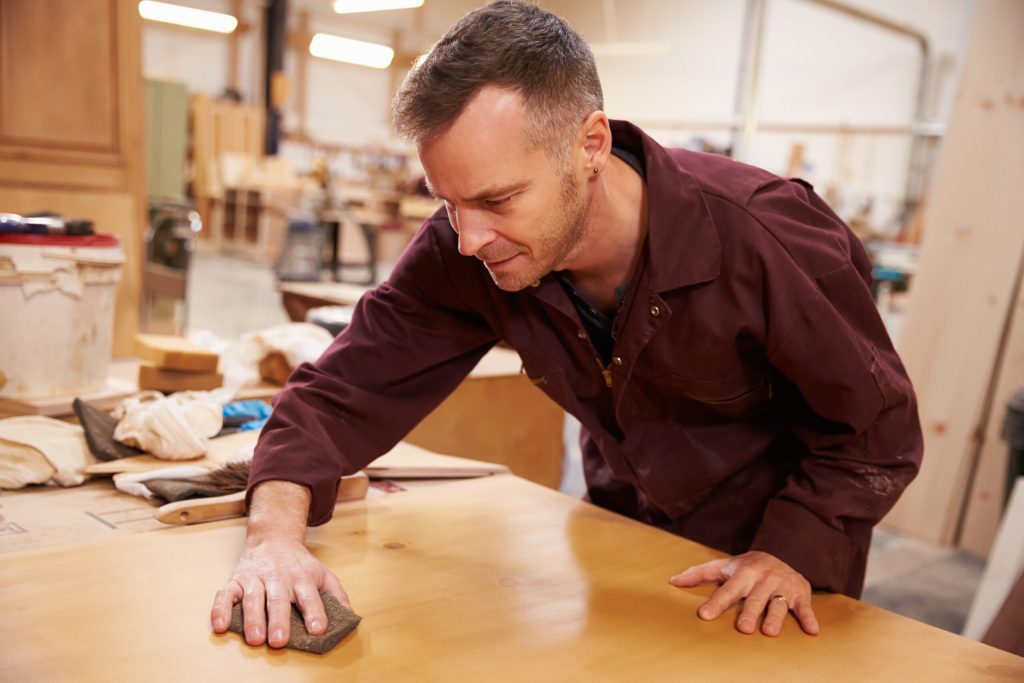
Now do you know when it’s time to refinish? Consider refinishing your wood floors if you see any of the following:
Fading or Discoloration: If you notice some areas of your floor look lighter than others, especially in rooms with lots of natural light, it’s a sign that refinishing is needed to bring the wood back to its original, even tone.
Visible Scratches and Wear: High-traffic areas, especially on hand-scraped or distressed floors, can develop noticeable wear patterns. These areas may look more worn or dull compared to the rest of the floor.
Loss of Shine: If your floors have lost their luster and no longer reflect light the way they used to, refinishing will restore that beautiful shine.
Dull or Dry Appearance: Over time, Amish floors can start to look dry or dull as the finish wears away, exposing the wood to potential damage from moisture and everyday wear and tear.
Choosing the Right Finish for Your Amish Wood Floors
When it comes to finishes, not all are created equal, especially for Amish hardwood floors. The type of finish you choose can dramatically affect both the look and durability of your wood floors.
If you own cherry floors, for instance, you might opt for a finish that enhances the rich, reddish hues of the wood, whereas maple floors might benefit from a finish that highlights their lighter, natural tones. Oil-based finishes tend to bring out the grain more, giving your floors a rich, warm look, while water-based finishes offer a clearer, more matte appearance.
When selecting a finish, it’s important to consider how it will affect the wood’s natural beauty. For example, a glossy finish might bring out the depth of grain in oak, but a matte finish could give your floors a more modern, understated elegance. Whatever finish you choose, make sure it’s appropriate for the type of wood and style you’re working with.
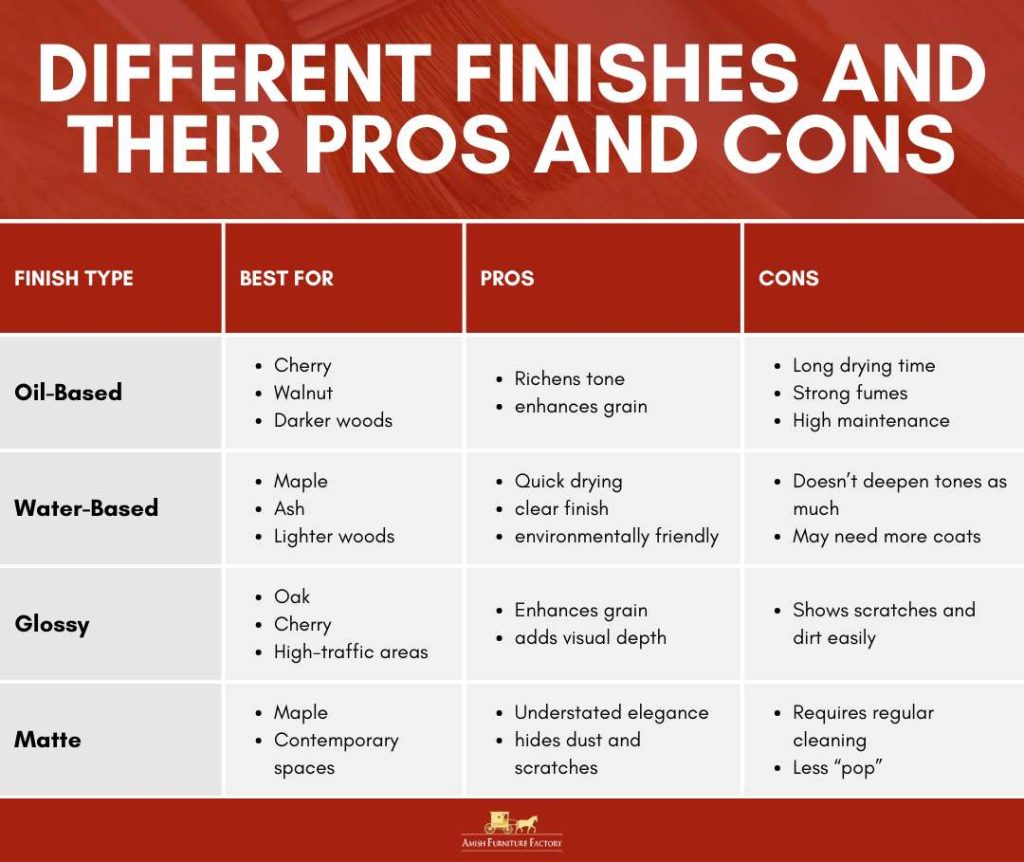
Essential Steps for Refinishing Amish Wood Floors
When refinishing Amish hardwood floors, selecting the right tools is essential. Given the premium quality and density of the wood, it’s important to use tools that are gentle enough to protect the intricate grain while being strong enough to remove old finishes and imperfections.
Here’s a list of the key tools and products you’ll need:
- Sandpaper
- Coarse grit (40-60) can damage the surface.
- Fine grit (100–150) may not remove enough material.
- Aim for a medium grit (80–120) for balanced results.
- Orbital Sander
- Edge Sander
- Dust mask and safety glasses
- Floor buffer
- Vacuum and Tack Cloth
Step-by-Step Guide to Refinishing Amish Wood Floors
Refinishing Amish floors is a detailed process, but when done right, it can restore the original beauty and protect them for years to come.
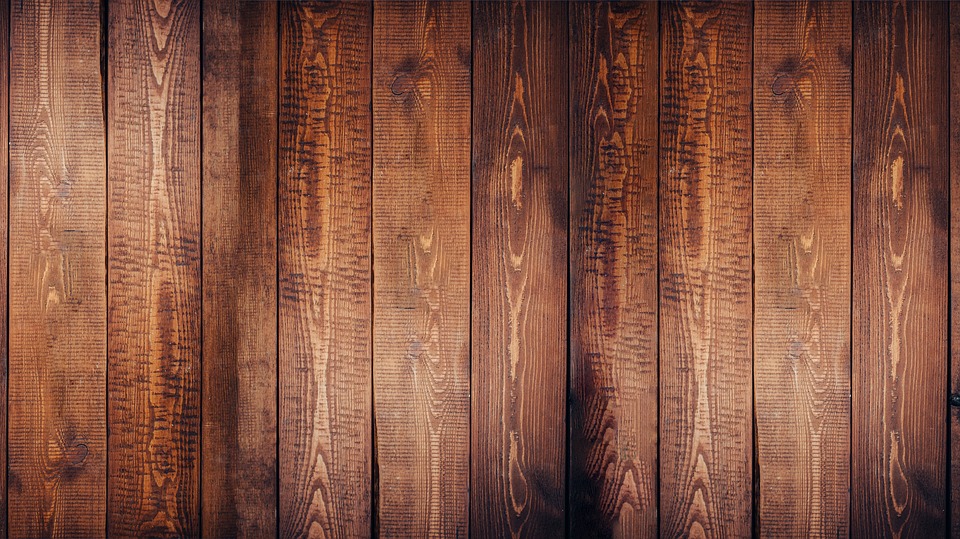
1. Preparation
- Clear the Space: Remove all furniture and rugs from the area. This includes any delicate items that could be damaged during the finishing process.
- Thoroughly Clean the Floors: Sweep or vacuum the floors to remove any dust and debris. Follow this with a damp mop using a wood-safe cleaner to ensure all residues are gone. Let the floor dry completely before proceeding.
- Inspect for Damage: Look for any cracks or holes in the wood. These should be filled with wood filler to ensure a smooth surface for sanding and finishing.
2. Sanding
- Select the Right Sander: Use a high-quality floor sander suited for your floor type. For large, flat areas, a drum sander is often the best choice, while edge sanders can help with corners and tight spots.
- Choose the Appropriate Sandpaper: Start with coarse sandpaper (e.g., 36-grit) to remove the old finish. For softer woods like cherry, consider using a finer grit (e.g., 60 or 80) to avoid damaging the wood fibers.
- Sanding Technique: Sand with the grain of the wood to avoid scratches. For distressed or hand-scraped floors, use a lighter touch to preserve the wood’s unique character. After the initial sanding, progress to finer grits (80–120) to achieve a smooth finish.
- Troubleshooting common mistakes:
- If you notice uneven spots or missed areas, resand those sections carefully.
- To avoid sanding marks, always keep the sander moving and avoid staying in one spot too long.
3. Staining (Optional)
- Choosing the Right Stain: If you wish to change the color of your floors, select a stain that complements the natural beauty of Amish woods like cherry or oak. Test the stain on a small, inconspicuous area first to ensure you’re happy with the color.
- Application Tips: Use a clean, lint-free cloth or a foam application to apply the stain. Work in sections to maintain a wet edge, preventing lap marks.
- Mindful of Wood’s Natural Beauty: Sometimes, less is more. A light application can enhance the wood’s natural grain without overpowering it. Always follow the manufacturer’s instructions for drying times before applying additional coats.
4. Finishing
- Select Your Finish: Choose between oil-based or water-based finishes, matte or glossy, based on your desired look and durability needs. Oil-based finishes typically offer a warmer tone and longer drying times, while water-based options dry faster and have lower odor.
- Application Process: Using a high-quality brush or applicator, apply the finish in thin, even coats, following the wood grain. Avoid overloading your application to prevent drips and bubbles.
- Drying Between Coats: Be patient during this step. Allow each coat to dry according to the manufacturer’s instructions and lightly sand between coats with fine sandpaper (220 grit) to ensure a smooth surface.
- Troubleshooting Common Issues:
- If you encounter bubbles in the finish, it may be due to applying too thick a coat or using a brush that’s too stiff. Lightly sand the area to smooth it out and reapply.
- If the finish looks uneven, consider a second coat after proper drying, ensuring to sand lightly between applications.
5. Maintainance
To keep your refinished Amish wood floors looking beautiful and ensure their longevity, follow these simple steps for proper care and maintenance.
- Regular Cleaning
- Sweep or vacuum regularly using a soft-bristle broom or a vacuum with a hardwood floor attachment to remove dirt and debris.
- Mop with a slightly damp microfiber mop—avoid using excess water, as it can cause the wood to warp.
- Use mild, wood-safe soaps or plant-based cleaners (such as Bona or Method) to clean your floors and protect the finish.
- Humidity Control
- In the winter, use a humidifier to maintain indoor humidity levels between 35-55%. This helps prevent gaps between the planks.
- In the summer, use a dehumidifier to control excess moisture, reducing the risk of wood expansion and buckling.
- Consider using a hygrometer to monitor humidity levels year-round.
- Wood Polish and Conditioning
- After a few months, apply a wood polish designed for hardwood floors to maintain the shine and luster of your refinished floors.
- For an eco-friendly option, use Amish-made polishes.
- Periodically apply a non-toxic, oil-based wood conditioner to nourish the wood, especially in dry climates, and keep it hydrated.
Common Mistakes to Avoid When Refinishing Amish Wood Floors
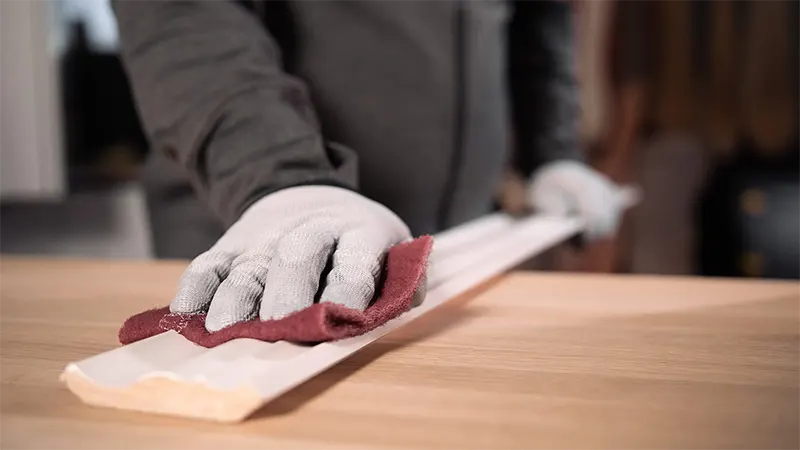
Refinishing Amish wood floors requires care to maintain their natural beauty. One common mistake is oversanding. Sanding too aggressively can damage the wood’s unique grain patterns and handcrafted character. Instead, use a light touch and the right grit sandpaper to preserve these features.
Another mistake is choosing the wrong finish. Amish hardwoods have a natural beauty that doesn’t need heavy stains or paints or high-gloss coatings. Opt for finishes that enhance, rather than mask, the wood’s intricate grain and texture.
Lastly, rushing the process can lead to poor results. Be patient and allow each coat of finish to dry fully before applying the next. Taking your time ensures a durable, polished look that highlights the craftsmanship of Amish wood.
Discover the timeless beauty and durability of Amish wood floors with expert refinishing tips. Visit the Amish Furniture Factory to explore premium wood flooring options and elevate your space today!
Conclusion
Refinishing Amish wood floors is more than just a maintenance task—it’s a way to preserve a piece of craftsmanship that can be passed down through generations. With their high-quality hardwoods, intricate grain patterns, and artisan touches, these floors deserve special care and attention. Whether you’re maintaining distressed or smooth-grain styles, following the right steps and choosing the appropriate materials will keep your floors looking timeless.
FAQs
What is the difference between resurfacing and refinishing?
Resurfacing involves replacing parts of the wood flooring, while refinishing simply means sanding and applying a new finish to the existing wood. Refinishing is less invasive and typically the preferred option for well-maintained hardwood floors.
Can I refinish my hardwood floors myself?
Yes, but refinishing is a labor-intensive process that requires specific tools and skills. If you have Amish wood floors, it’s advisable to work with a professional who understands how to handle premium hardwood.
Can wood floors be refinished without sanding?
Yes, wood floors can sometimes be refinished without sanding, especially if the wear is limited to surface-level damage like light scratches or dullness. In these cases, a process called “screening” or “buffing” can be used to roughen the surface before applying a new coat of finish. However, if there are deep scratches, dents, or significant wear, sanding is required to remove the damage and restore the wood’s original appearance.
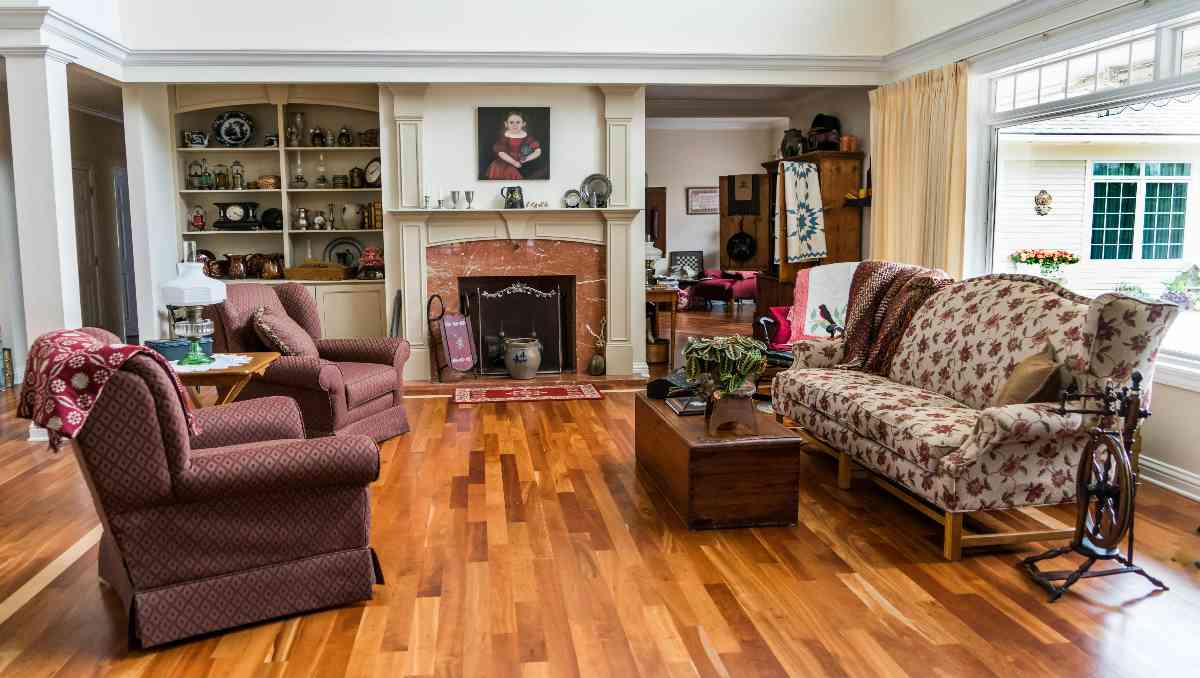
Hello. I am wondering if you do floor refinishing? WE also need a linoleum tile foyer pulled up and the floor below evaluated to see if that, too can be refinished.
Thank you.
We live in Princeton close to the Amish Market on Rt. 27 in Princeton, NJ
609 9156440
We don’t do floor refinishing. It’s just furniture and accessories for us. Thanks for asking.